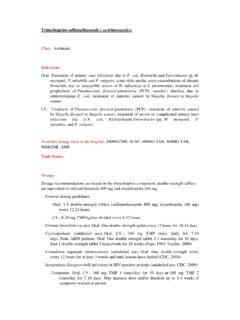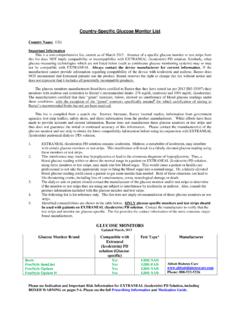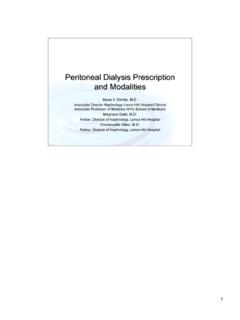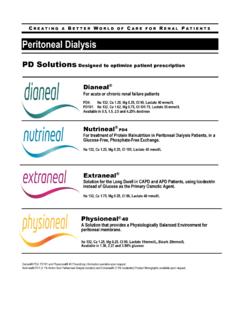Transcription of Scrotal Edema Secondary to Fluid Imbalance in …
1 Advances in peritoneal dialysis , Vol. 25, 2009 Scrotal Edema Secondary toFluid Imbalance in Patientson Continuous PeritonealDialysisIn addition to local causes for example, leak ofdialysate into an inguinal hernia sac or into theanterior abdominal wall through the track of thecatheter for continuous peritoneal dialysis (CPD) Scrotal Edema in CPD patients may result fromgeneralized volume retention. We present 2 CPDpatients with Scrotal Edema , illustrating the diag-nosis and management of the mechanisms of vol-ume man with hypertensive nephrosclerosis devel-oped isolated Scrotal Edema 14 months after an un-eventful course of continuous ambulatory peritonealdialysis (CAPD). After repair of a ventral herniaand of a communicating hydrocele, he started con-tinuous cycling peritoneal dialysis (CCPD), plus 2daytime CAPD exchanges.
2 After 4 months, he againdeveloped isolated Scrotal Edema , which decreasedat night. peritoneal scintigraphy showed no dialy-sate leaks, and peritoneal equilibration test (PET)revealed high-average transport with a residual vol-ume above, and an ultrafiltration volume below, theexpected range. Abdominal radiography revealedmigration of the CPD catheter. Malposition of theCPD catheter with positional retention of dialysatewas diagnosed. The patient was treated with nightlyperitoneal dialysis and no daytime exchanges. Onthis regimen, ultrafiltration improved and the scro-tal Edema disappeared with no recurrence for 5months, at which point the patient underwent kid-ney man with diabetic nephropathy developed poordialysate return, volume gain, and pronouncededema of the scrotum, penis, and both legs soonafter starting CAPD.
3 peritoneal scintigraphy wasnegative, and abdominal radiography confirmedthe appropriate position of the CPD catheter tipin the right lower abdominal quadrant. PET re-vealed high peritoneal solute transport, appropri-ate residual volume, and appropriate for thetransport category, but relatively low ( L), ul-trafiltration volume. He was treated with a changein the CPD procedure to CCPD, plus 1 daytimeicodextrin exchange and instruction to reduce saltintake. This patient has remained free of scrotaledema for 6 men on CPD, Scrotal Edema can developfrom generalized volume gain Secondary to eitherCPD catheter malfunction or Imbalance betweentotal Fluid removal and salt and water interpretation of PET findings is criticalin the evaluation of Scrotal Edema not resultingfrom internal dialysate leaks in wordsScrotal Edema , ultrafiltration failure, peritonealtransportIntroductionIn men on continuous peritoneal dialysis (CPD), scro-tal Edema may result from several mechanisms.
4 Thediagnostic methods and management of these mecha-nisms vary. The clinical presentation usually deter-mines the sequence of diagnostic first mechanism is local. Dialysate leakthrough a hernia or weak point in the CPD cathetertrack leads to dissection of Fluid into the scrotalspaces (1,2). Clinical examination is of paramountimportance for the detection of hernias, but also in theassessment of the extent of the Edema . With a leak,the Edema is typically limited. Imaging is used toevaluate the anatomy of internal dialysate leaks (3,4).This type of Scrotal Edema is usually addressed withsurgical Adeniyi,1 Brenda Wiggins,1 Yitzuan Sun,1 KarenS. Servilla,1 Michael F. Hartshorne,2 Antonios : 1 Section of Nephrology and 2 Radiology Service,Raymond G. Murphy VA Medical Center and University ofNew Mexico School of Medicine, Albuquerque, NewMexico, et second broad category of conditions leadingto the development of Scrotal Edema in men on CPDis generalized Fluid retention, which can be CPDcatheter related, Secondary to peritoneal transportcharacteristics, a result of dietary habits, or a combi-nation of two or more of the foregoing conditions.
5 Inthis case, Fluid retention results from an imbalancebetween salt and Fluid intake and peritoneal plusurinary output, and the Scrotal Edema is usuallyassociated with other clinical signs of Fluid detailed protocol for evaluating CPD patients withlarge Fluid gains, based on Twardowski s peritonealequilibration test [PET (5)], has been produced (6).Patients with retention of dialysate in the peritonealcavity because of CPD catheter malposition or mal-function are treated by mechanical intervention onthe CPD catheter (1). Patients with ultrafiltration fail-ure or excessive dietary salt intake are treated bychanging the dialytic and dietetic prescriptions (7,8).The elucidation of the mechanism of scrotaledema development in CPD patients can be compli-cated. Here, we present 2 patients in whom past medi-cal history strongly suggested local causes, butevaluation by multiple diagnostic tests disclosedcauses of Scrotal Edema that were treated by changesin the prescription of peritoneal and methodsCase report: patient 1A 53-year-old man with end-stage renal disease(ESRD) Secondary to hypertensive nephrosclerosiscommenced chronic hemodialysis (HD) in March2006.
6 In April 2006, he underwent partial pancre-atectomy for a pancreatic mucinous cyst. In August2006, he underwent a second major abdominal sur-gery for lysis of symptomatic adhesions and place-ment of a peritoneal dialysis was subsequently started on continuous ambu-latory peritoneal dialysis (CAPD) with 5 daily ex-changes using fill volumes alternating and dextrose content. For the next 14months, he did well on this regimen. The initial PETrevealed high-average transport, with appropriate re-sidual and drain volumes (Table I). Weekly total Kt/Vurea was, on three occasions, between and November 2007, this patient developed weightgain with poor return of spent dialysate and scrotalsac enlargement that decreased at night. Physicalexamination revealed a ventral hernia and a leftinguinal hernia with communicating left of the penis or any other site outside the scro-tum was not noticed.
7 The hernia and hydrocele werecorrected surgically. The patient was treated withHD for 6 weeks and then started peritoneal dialysiswith 4 nightly cycler exchanges, 2 daytime ex-changes, and a fill volume alternating and dextrose content. The change inthe CPD prescription was of his own choice. Again,a PET revealed high-average transport with appro-priate residual and ultrafiltration volumes (Table I),and weekly Kt/V urea was He did well for about4 months on this April 2008, the patient had a recurrence ofpoor Fluid drainage in the daytime, with weight gainof approximately 4 kg and Scrotal swelling. Physicalexamination revealed Scrotal Edema , no Edema inother areas, and no hernias. peritoneal scintigraphyusing technetium sulfur colloid (3) was performedfirst because of his past medical history; this test dis-closed no Fluid leaks.
8 Another PET revealed high-average transport, but this time the residual volumewas elevated, and the ultrafiltration volume was be-low the expected range. Plain abdominal radiographsshowed migration of the peritoneal catheter with thetip in the right upper abdominal quadrant. Positionalcatheter malfunction with retention of dialysate inthe upright position was diagnosed. Prescription oflaxatives did not change the position of the patient refused further manipulations and wastreated with intermittent nightly peritoneal dialysis :10 hours on a cycler, 5 exchanges, and a 3-L fill vol-ume. The weight gain and Scrotal Edema ultrafiltration volumes were appropriate,and the weekly total Kt/V urea was and ontwo occasions. No recurrence of the Edema or weightTABLE IPeritoneal equilibration test resultsResidualD/PUFvolumecreatininevolu mePatient(L)(4-h)(L)1(a) (b) (c) range (5,6)< = dialysate-to-plasma ratio; UF = Scrotal Edema in PDgain was observed up to September 2008, when thepatient received a successful renal report: patient 2A 60-year-old man with ESRD Secondary to diabeticnephropathy commenced chronic HD in July August 2008, a CPD catheter was surgically in-serted without difficulty.
9 This patient had had no priorabdominal surgeries. He returned for CPD trainingin September 2008, at which time it was noted thatfluid infusion was uneventful, but Fluid return didnot occur. Abdominal radiography verified theposition of the tip of the CPD catheter in the rightlower abdominal quadrant and indicated the pres-ence of a large amount of stool. Use of laxativescleared the bowel, but did not improve drainage ofthe CPD catheter. Repeated instillations of tissue plas-minogen activator (TPA) and heparin into the CPDcatheter also failed. In October 2008, the patient un-derwent laparotomy with lysis of adhesions and re-positioning of the CPD weeks later, he started CAPD with 4 dailyexchanges and a fill volume alternating and dextrose solution. Almost from thebeginning, he noticed low drain volumes and weightgain, with formation of gross swelling of the scrotumand penis that was uncomfortable.
10 On physical exami-nation, blood pressure was elevated (160/90 mmHg),and pronounced Edema of the scrotum and penis, aswell as of both lower extremities, was of the history of catheter malfunction andrepeated laparotomy with lysis of adhesions, a dialy-sate leak was suspected. However, peritoneal scin-tigraphy with technetium sulfur colloid failed to showany Fluid leaks. A PET revealed high-average trans-port with appropriate residual and ultrafiltration vol-umes (Table I). The patient was then treated withHD for 3 weeks. After disappearance of the scrotaland penile Edema and substantial reduction of thelower-extremity Edema , which had been a chronicproblem from before the onset of dialysis , the patientreturned to CPD. The CPD prescription was changedto nightly continuous cycling PD, with 4 exchangesof dextrose using a fill volume, plus 1exchange of icodextrin (2 L) in the daytime.








